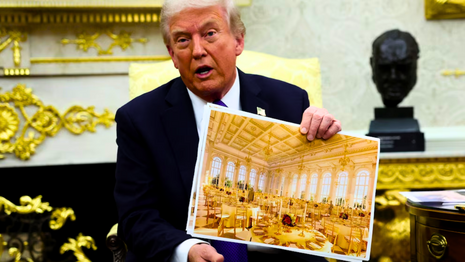 New Yorker magazine has an amusing analysis by art writer Adam Gopnik as to why President Donald Trump tore down the East Wing in order to build a new ballroom next to the White House. The supposed reason gives us insight into just how much corrosive TDS has eaten away at anything resembling rational thought at that periodical.
New Yorker magazine has an amusing analysis by art writer Adam Gopnik as to why President Donald Trump tore down the East Wing in order to build a new ballroom next to the White House. The supposed reason gives us insight into just how much corrosive TDS has eaten away at anything resembling rational thought at that periodical.
You can descend into the New Yorker rabbit hole in their bizarre screed published on Saturday in "Why Trump Tore Down the East Wing." The subtitle lays out the dopey thesis: "The act of destruction is precisely the point: a kind of performance piece meant to display Trump’s arbitrary power over the Presidency, including its physical seat."
And now the details of Gopnik's sanity-challenged premise:
The surprise and shock that so many people have registered at the photographs of Donald Trump’s destruction of the East Wing of the White House—soon to be replaced by his own ostentatious and overscaled ballroom—is itself, in a way, surprising and shocking. On the long list of Trumpian depredations, the rushed demolition might seem a relatively minor offense. After months marked by corruption, violence, and the open perversion of law, to gasp in outrage at the loss of a few tons of masonry and mortar might seem oddly misjudged.
And yet it isn’t. We are creatures of symbols, and our architecture tells us who we are. John Ruskin, the greatest of architectural critics, observed that a nation writes its history in many books, but that the book of its buildings is the most enduring. The faith in order and proportion embodied in the Alhambra, the romance of modernity caught in the Eiffel Tower’s lattice of iron—these are not ideas imposed on buildings but ideals that the buildings themselves express, more lastingly than words can. Among them, not least, is the modest, egoless ideal of democratic tradition captured so perfectly in such American monuments as the Lincoln Memorial, which shows not a hero but a man, seated, in grave contemplation.
You would think that the East Wing is some iconic architectural marvel marvel ranking right up there with the Alhambra, Eiffel Tower, and the Lincoln Memorial. However, even Gopnik soon admits that the East Wing has been somewhat unimpressive in its relatively brief life which amounts to less than a third of the age of the nation:
The East Wing has never been a place of grandeur. The structure as we knew it was built in the anxious years of the Second World War. It was Franklin Roosevelt’s attempt to regularize a jumble of service spaces and, not incidentally, to carve out a secure refuge beneath them. But it quickly became a center of quiet power. Eleanor Roosevelt hosted women journalists there. Two decades later, Jacqueline Kennedy presided over a different kind of transformation from the same offices, founding the White House Historical Association. The wing’s very plainness came to symbolize the functional modesty of democratic government: a space for staff, not spectacle; for the sustaining rituals of civic life, not the exhibition of personal glory.
Yeah, so a building constructed to "regularize a jumble of service spaces" as well as to serve as a cover for an underground bunker hardly sounds like the stuff of the Alhambra, Eiffel Tower, and the Lincoln Memorial by Gopnik's own admission.
All of that is now gone. The act of destruction is precisely the point: a kind of performance piece meant to display Trump’s arbitrary power over the Presidency, including its physical seat. He asks permission of no one, destroys what he wants, when he wants.
Sniff! An aging building which long ago lost its usefulness is now gone. And all because, according to Gopnik, so Trump could do his performance art of exercising "arbitrary power over the Presidency."
Earlier alterations were made incrementally, and only after much deliberation. When Harry Truman added a not very grand balcony to the Executive Residence, the move was controversial, but the construction was overseen by a bipartisan commission. By contrast, the new project—bankrolled by Big Tech firms and crypto moguls—is one of excess and self-advertisement. The difference between the Truman balcony and the Trump ballroom is all the difference in the world. It is a difference of process and procedure—two words so essential to the rule of law and equality, yet doomed always to seem feeble beside the orgiastic showcase of power.
Gopnik seems to think that Trump should have patiently waited for the long Byzantine process of bureaucratic review to play itself out. A process which in this era could take many, many years -- long after Trump's "arbitrary power" is gone.




